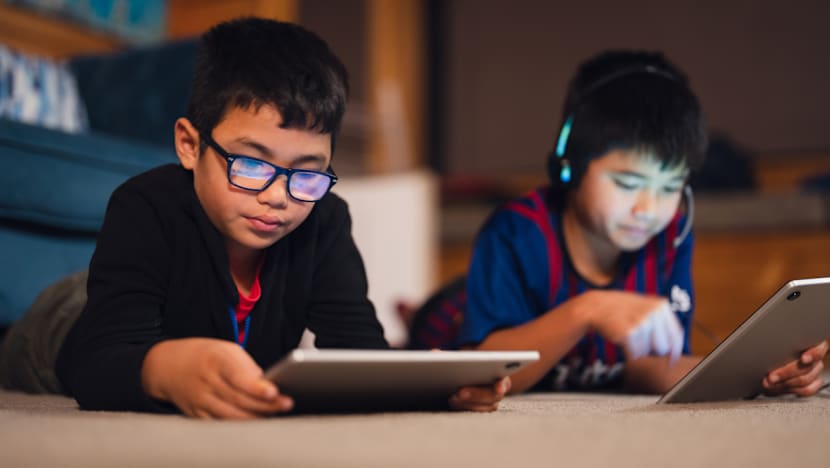Commentary: Conversations on kids’ screen time focus too much on quantity
Families should distinguish between intentional device use and passive consumption, say media scholars Chew Han Ei and Lim Sun Sun.

The goal is not constant supervision but helping children develop self-regulation habits. (Photo: iStock/nazar_ab)

This audio is generated by an AI tool.
SINGAPORE: More than half of children aged two to six are exceeding recommended daily screen time limits, according to a recent survey by the Ministry of Digital Development and Information (MDDI).
For many parents, this finding strikes uncomfortably close to home and heightens anxieties about the excessive dependence young people have on their devices.
But while it is easy to wag a finger at parents, the truth is more complicated. For many, devices are not simply a “lazy option” but a necessity – a way to keep children occupied when adults are juggling long hours, household demands and the rising pressures of modern life.
Parents of older children also find it a struggle to manage screen time when their kids need to access apps and devices for schoolwork, blurring the line between leisure and educational use. Such situations make imposing strict guidelines and “policing” device use a fraught exercise.
With screens being ubiquitous and device use interwoven into family and school life, how can we support parents and children to better manage screen time? Is the rising tide towards smartphone bans for children the inevitable solution or is there a middle path we can strike?
THE TEMPTATION OF BANS
Around the world, the debate over children and screens has tilted sharply toward restriction in recent years. Australia recently announced a reversal of policy that will see YouTube grouped with TikTok, Instagram and other platforms in its ban for under-16s. Over 30 American states now limit or ban phones in schools.
But bans create the illusion of safety because they rarely hold under real-world pressures. Even the strictest parental rules often collapse once classmates are online. Social pressure and peer influence almost always puncture prohibitions.
Adolescents who are suddenly granted full access at age 13 or 17 face the worst of both worlds: little preparation and the lure of something long kept out of reach. Restriction alone therefore risks delaying the problem without solving it.
Above all, bans ignore developmental reality. Children do not suddenly become digitally literate at 13 or 16; they must be guided gradually, in age-appropriate steps, with both guardrails and opportunities.
Recent research by Michigan State University researchers also found that casual online activities – from playing video games to browsing social media – can help adolescents build digital skills and even boost academic performance, especially on standardised tests like the SAT.
Clearly, we cannot just ask how much media children use. The more crucial issue is what they learn and how they are supported in learning it.
PUTTING “TRAINING WHEELS” ON DEVICES
Instead of blunt prohibitions, families can adopt graduated exposure. Oxford professor Andrew Przybylski, for instance, gave his children their first phones since the age of three – but without internet access. Instead, their devices started with no more than an album of family pictures.
Progressively, he introduced more features such as access to the camera, a carefully curated set of audiobooks and songs, and eventually, the ability to call and text family. At each stage, the device was introduced with intention, conversation and gradual responsibility. He likened it to putting training wheels on bicycles.
Currently, Singapore’s own guidelines take an age-based approach, aligned with young people’s key developmental stages. The Ministry of Health recommends no screen time for children under 18 months, under an hour daily for ages 18 months to six years, and under two hours for children aged seven to 12.
Yet the MDDI survey found that only 37 per cent of parents felt confident about guiding their child’s digital habits. Parents with little or no confidence pointed to constraints such as limited time, children resisting rules or bypassing controls, and their own lack of knowledge about monitoring tools.
In response, MDDI released a positive use guide on technology and social media that offers strategies for families such as co-watching and modelling positive behaviours.
NOT ALL SCREEN TIME IS EQUAL
The foundational lesson for families is that not all screen time is the same. They should ask not only “How long?”, but “What happens during those minutes or hours?”
Families should distinguish between intentional use and passive consumption. Watching a curated playlist of educational videos is not the same as endless doomscrolling.
By embedding literacy about these differences into school media literacy classes and parent workshops, we can help children derive more value from screen time while avoiding potential pitfalls. Awareness must also be raised about design features such as infinite scroll and autoplay that can induce overuse.
Co-use, intentional content selection and open conversations matter. For instance, on the topic of gaming, parents can ensure their children do not have unbridled access to all video games, and talk to their children about it to connect and impart skills such as digital literacy.
Ultimately, the goal is not constant supervision but helping children develop self-regulation habits – the ability to recognise when to switch off and balance online with offline life.
RESILIENCE BY DESIGN
For now, Singapore has chosen guidance over prohibition on children’s device use.
The next step is to strengthen the “training wheels” – by embedding digital literacy into school curricula, building parent confidence and requiring platforms to take responsibility for design choices that amplify risk.
Tech companies must also play their part by offering child-friendly defaults, simpler dashboards and risk audits. In this way, scaffolding becomes a collective effort. Parents guide where they can; institutions step in where they cannot.
The challenge now is to prepare children for the digital world they will inevitably inhabit. We should focus on quality over quantity: to make screen minutes matter, to share the work of scaffolding, and to hold platforms accountable for their designs.
If we succeed, we will give our children not just devices, but the skills and resilience to use them well. That is the true measure of digital health.
Chew Han Ei is Senior Research Fellow and Head of Governance and Economy at the Institute of Policy Studies, National University of Singapore.
Lim Sun Sun is Vice President, Partnerships and Engagement at the Singapore Management University and Lee Kong Chian Professor of Communication and Technology at its College of Integrative Studies.








.png?itok=YiqRJsWN)


.png?h=3bbeb2bd&itok=Vq2q0go8)







